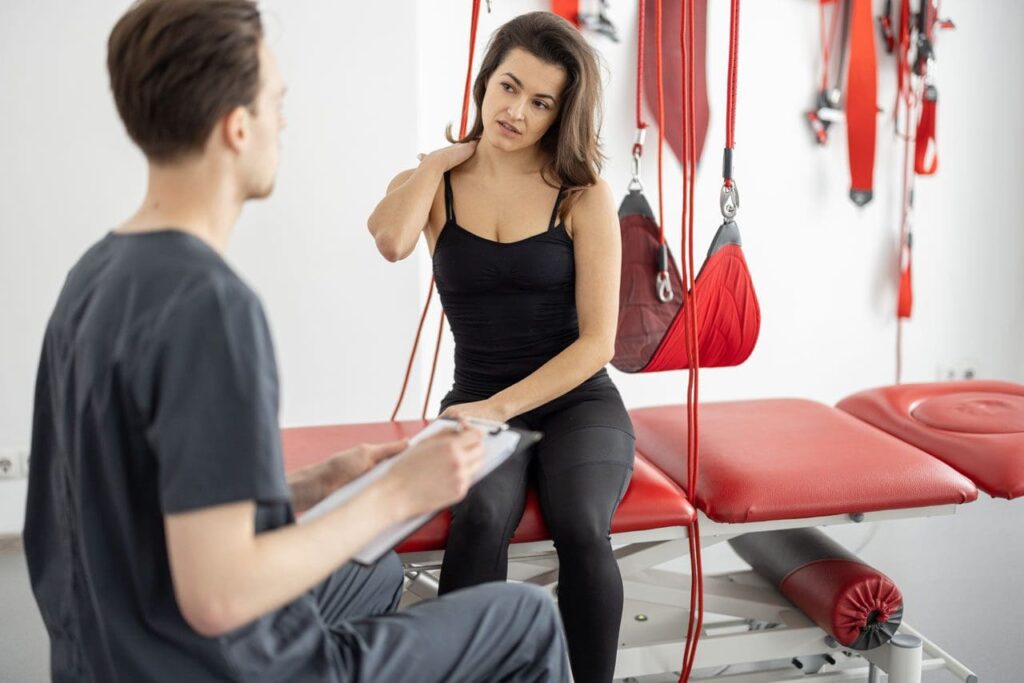Chiropractic Care Uncovered Inflammation Within The Musculoskeletal System
Unlock the potential of chiropractic care for managing musculoskeletal inflammation and promoting better health outcomes.
Chiropractic Care for Joint and Muscle Pain Associated with Inflammation: A Comprehensive Guide
Introduction
Imagine waking up with a stiff back or aching joints that make every step feel like a chore. For many, this isn’t just a bad day—it’s a sign of chronic inflammation, a sneaky culprit behind persistent musculoskeletal pain. Inflammation is like an overzealous houseguest: helpful at first, but problematic when it overstays its welcome. Chiropractic care offers a promising, non-invasive solution to manage this pain by focusing on the spine, nervous system, and holistic wellness. In this blog post, we’ll explore the clinical rationale for why chiropractic care can help with joint and muscle pain linked to inflammation, dive into scientific evidence, and spotlight the work of Dr. Alexander Jimenez, a distinguished chiropractor in El Paso, TX. We’ll also weave in insights on how environmental factors, gut health, and nutrition play a role, with a dash of humor to keep things light—because who said learning about health can’t be fun?
Section 1: Understanding Inflammation and Musculoskeletal Disorders
What is Inflammation?
Inflammation is your body’s natural defense mechanism, kicking in when you sprain an ankle or fight off a virus. Acute inflammation is a short-term response that helps heal injuries by increasing blood flow and enhancing immune activity. However, chronic inflammation—when the body’s alarm system remains activated for too long—can lead to tissue damage, pain, and conditions such as arthritis or low-back pain. Think of it as your body’s fire alarm blaring even after the fire’s out.
Inflammation and Musculoskeletal Disorders
Chronic inflammation is a key player in musculoskeletal disorders, which affect joints, muscles, and bones. For instance, research suggests that iron overload, a condition in which excess iron accumulates in the body, can exacerbate musculoskeletal symptoms, contributing to conditions such as arthritis (Vasquez, 1996). This study highlights the need to consider underlying factors when treating pain, as factors beyond physical injury can trigger inflammation.
Environmental factors also fuel chronic inflammation. Pollution, stress, and poor lifestyle choices can create a perfect storm for pain. For example, a sedentary lifestyle can weaken muscles and lead to poor posture, which in turn increases inflammation in the spine and joints. A study on gluteal muscle activation during walking revealed that enhancing muscle function can alleviate low-back pain, a common inflammatory-related issue (Bullock-Saxton, 1996). This suggests that movement and proper alignment are critical for managing inflammation.
The Impact on Individuals
Chronic inflammation doesn’t just cause physical pain—it can affect your quality of life. Imagine trying to play with your kids or enjoy a hike when every movement hurts. Over time, this can lead to reduced mobility, fatigue, and even emotional stress. Addressing inflammation holistically, through approaches like chiropractic care, can help break this cycle.
References
- Vasquez, A. (1996). Musculoskeletal disorders and iron overload disease: Comment on the American College of Rheumatology guidelines. Arthritis & Rheumatism, 39(10), 1767–1768. https://doi.org/10.1002/art.1780391027
- Bullock-Saxton, J. E. (1996). Reflex activation of gluteal muscles in walking. An approach to the restoration of muscle function for patients with low-back pain. Spine, 21(6), 704–715. https://pubmed.ncbi.nlm.nih.gov/8516698/
Section 2: The Clinical Rationale for Chiropractic Care
How Chiropractic Care Works
Chiropractic care centers on the idea that a healthy spine supports a healthy body. Misalignments in the spine, known as subluxations, can irritate nerves, disrupt blood flow, and contribute to inflammation. Chiropractors use spinal adjustments—gentle, controlled movements—to correct these misalignments, aiming to restore proper nerve function and reduce pain. It’s like realigning the wheels of a car to ensure a smooth ride.
Reducing Inflammation Through Adjustments
Spinal adjustments may help reduce inflammation by improving nerve communication and blood flow. When nerves are irritated, they can trigger inflammatory responses in nearby tissues. By correcting spinal misalignments, chiropractors may alleviate this irritation, potentially lowering inflammation. A study on the Spinal Proprioceptive Extension Exercise Dynamic (SPEED) program showed that targeted exercises, similar to those used in chiropractic care, reduced back pain and improved balance in women with osteoporosis-related kyphosis (Sinaki et al., 2005). This suggests that enhancing spinal function can have a direct impact on inflammation-related pain.
A Holistic Approach
Chiropractors don’t just focus on the spine—they often incorporate lifestyle changes to address inflammation. For example, they may recommend exercises to strengthen muscles or dietary changes to reduce inflammatory foods. This holistic approach aligns with findings from a study on lowering medical care costs, which showed that preventive programs, including holistic practices, can significantly lower healthcare utilization (Orme-Johnson et al., 1997).
Avoiding NSAID Risks
Nonsteroidal anti-inflammatory drugs (NSAIDs) are commonly used for pain relief, but they come with risks, such as gastrointestinal complications. Research estimates that NSAIDs cause approximately 107,000 hospitalizations and 16,500 deaths annually among arthritis patients alone (Singh, 1998). Chiropractic care offers a drug-free alternative, potentially reducing reliance on NSAIDs and their associated risks.
References
- Sinaki, M., Brey, R. H., Hughes, C. A., Larson, D. R., & Kaufman, K. R. (2005). Significant reduction in risk of falls and back pain in osteoporotic-kyphotic women through a Spinal Proprioceptive Extension Exercise Dynamic (SPEED) program. Mayo Clinic Proceedings, 80(7), 849–855. https://pubmed.ncbi.nlm.nih.gov/16007888/
- Orme-Johnson, D. W., Herron, R. E., & Gelderloos, P. (1997). An innovative approach to reducing medical care utilization and expenditures. American Journal of Managed Care, 3(1), 135–144. https://pubmed.ncbi.nlm.nih.gov/10169245/
- Singh, G. (1998). Recent considerations in nonsteroidal anti-inflammatory drug gastropathy. American Journal of Medicine, 105(1B), 31S–38S. https://pubmed.ncbi.nlm.nih.gov/9715832/
Section 3: Dr. Alexander Jimenez’s Expertise in El Paso
Who is Dr. Jimenez?
Dr. Alexander Jimenez, DC, APRN, FNP-BC, is a leading chiropractor and nurse practitioner based in El Paso, TX. At his clinic, ChiroMed – Integrated Medicine, he offers a range of services, including chiropractic adjustments, nutrition counseling, acupuncture, and rehabilitation. His dual expertise allows him to provide comprehensive care that addresses both the physical and systemic aspects of inflammation-related pain (ChiroMed, n.d.).
Personal Injury Cases
In El Paso, personal injury cases—such as those from car accidents or workplace injuries—are common, and they often involve significant musculoskeletal trauma. Dr. Jimenez excels in these cases, utilizing advanced imaging techniques (e.g., X-rays, MRIs) and comprehensive diagnostic evaluations to assess injuries accurately. His dual-scope approach—combining chiropractic and medical expertise—enables him to create tailored treatment plans that address inflammation and promote recovery. He also acts as a liaison between medical care and legal documentation, ensuring that patients’ injuries are properly documented for insurance or legal claims.
Holistic Care for Inflammation
Dr. Jimenez’s approach goes beyond adjustments. He emphasizes the importance of nutrition, exercise, and stress management to reduce inflammation. For example, he might recommend anti-inflammatory foods, such as berries or omega-3-rich fish, aligning with research on the effects of nutrients on brain and body health (Gómez-Pinilla, 2008). His integrative methods make him a trusted practitioner for those seeking relief from chronic pain.
References
- ChiroMed – Integrated Medicine. (n.d.). Retrieved from https://chiromed.com/
- Gómez-Pinilla, F. (2008). Brain foods: The effects of nutrients on brain function. Nature Reviews Neuroscience, 9(7), 568–578. https://pubmed.ncbi.nlm.nih.gov/18568016/
Section 4: Environmental Factors and Chronic Inflammation
The Role of Environment
Your environment plays a big role in inflammation. Pollution, for instance, can introduce toxins that trigger inflammatory responses. A study on the gut microbiome还不
References
- Cryer, L. M., & Rogers, J. T. (2019). The gut microbiome in neurological disorders. Trends in Neurosciences, 42(3), 159–173. https://pubmed.ncbi.nlm.nih.gov/31753762/
- Sinaki, M., Brey, R. H., Hughes, C. A., Larson, D. R., & Kaufman, K. R. (2005). Significant reduction in risk of falls and back pain in osteoporotic-kyphotic women through a Spinal Proprioceptive Extension Exercise Dynamic (SPEED) program. Mayo Clinic Proceedings, 80(7), 849–855. https://pubmed.ncbi.nlm.nih.gov/16007888/
Unlocking the Secrets of Inflammation- Video
Section 5: Scientific Perspectives on Inflammation and Health
Gut Microbiome and Inflammation
The gut microbiome—the community of bacteria in your digestive tract—has a surprising link to inflammation. Research suggests that an imbalanced gut microbiome can lead to systemic inflammation, which may contribute to the development of musculoskeletal and neurological disorders (Cryer & Rogers, 2019). Chiropractic care, by improving nervous system function, may indirectly support gut health by reducing stress on the body, though direct evidence is still emerging.
Mitochondria and Osteoarthritis
Mitochondrial dysfunction is a key factor in osteoarthritis, a condition characterized by cartilage degradation and inflammation. Studies show that mitochondria, the powerhouses of cells, can contribute to oxidative stress and inflammation when impaired (Blanco et al., 2011). While chiropractic care doesn’t directly target mitochondria, reducing spinal stress may support overall cellular health, potentially aiding in the management of osteoarthritis.
Brain Plasticity and Spinal Injuries
Spinal cord injuries trigger changes in brain plasticity, the brain’s ability to adapt and reorganize. A systematic review found that both spontaneous and rehabilitation-induced plasticity can aid recovery from spinal cord injuries (Calderone et al., 2024). Chiropractic care, by improving spinal function, may support the nervous system’s adaptability, though more research is needed to confirm this connection.
Nutrition and Brain Health
What you eat can significantly impact inflammation and brain function. Foods rich in omega-3 fatty acids, antioxidants, and vitamins—like fatty fish, leafy greens, and berries—can reduce inflammation and support cognitive health (Gómez-Pinilla, 2008). Chiropractors often incorporate nutritional counseling into their practices, emphasizing the role of diet in managing inflammation.
References
- Cryer, L. M., & Rogers, J. T. (2019). The gut microbiome in neurological disorders. Trends in Neurosciences, 42(3), 159–173. https://pubmed.ncbi.nlm.nih.gov/31753762/
- Blanco, F. J., Rego, I., & Ruiz-Romero, C. (2011). The role of mitochondria in osteoarthritis. Nature Reviews Rheumatology, 7(3), 161–169. https://pubmed.ncbi.nlm.nih.gov/21200395/
- Calderone, A., Cardile, D., De Luca, R., Quartarone, A., Corallo, F., & Calabrò, R. S. (2024). Brain plasticity in patients with spinal cord injuries: A systematic review. International Journal of Molecular Sciences, 25(4), 2224. https://pubmed.ncbi.nlm.nih.gov/38396902/
- Gómez-Pinilla, F. (2008). Brain foods: The effects of nutrients on brain function. Nature Reviews Neuroscience, 9(7), 568–578. https://pubmed.ncbi.nlm.nih.gov/18568016/
Section 6: Addressing Controversies in Chiropractic Care
Scope of Practice Debates
Chiropractic care has faced scrutiny, particularly regarding its scope of practice. A 2006 lawsuit by the Texas Medical Association challenged chiropractors’ ability to perform certain procedures, arguing that they exceeded their training (Texas Medical Association, 2006). While this highlights the need for clear boundaries, it also underscores the importance of choosing qualified chiropractors who adhere to evidence-based practices.
Chiropractic vs. Medication
The reliance on medications like NSAIDs, which carry risks like gastrointestinal complications, has led to disillusionment in some healthcare systems. A study on Dutch healthcare criticized the preference for drugs over dietary interventions, suggesting that holistic approaches, such as chiropractic care, could offer safer alternatives (vd Steen & Ho, 2001). Chiropractic care’s focus on natural healing aligns with this shift toward preventive, non-invasive treatments.
Cost-Effectiveness
Chiropractic care can be cost-effective compared to traditional medical interventions. A study on a multicomponent prevention program showed significant reductions in medical care utilization and expenditures, suggesting that holistic approaches, such as chiropractic care, can help reduce healthcare costs (Orme-Johnson et al., 1997).
References
- Texas Medical Association. (2006). Physicians Ask Court to Protect Patients From Illegal Chiropractic Activities. Retrieved from https://www.texmed.org/Template.aspx?id=5259
- Vd Steen, W. J., & Ho, V. K. Y. (2001). Drugs versus diets: Disillusions with Dutch health care. Acta Biotheoretica, 49(2), 125–140. https://pubmed.ncbi.nlm.nih.gov/11450808/
- Orme-Johnson, D. W., Herron, R. E., & Gelderloos, P. (1997). An innovative approach to reducing medical care utilization and expenditures. American Journal of Managed Care, 3(1), 135–144. https://pubmed.ncbi.nlm.nih.gov/10169245/
Section 7: The Evolution of Chiropractic Care
Historical Context
Chiropractic care has evolved significantly since its inception in the late 19th century. The profession faced significant opposition from organized medicine, as detailed in historical accounts of the Wilk v. American Medical Association lawsuit (Dynamic Chiropractic, n.d.). Despite these challenges, chiropractic has evolved into a recognized healthcare discipline, with growing evidence supporting its effectiveness for musculoskeletal conditions.
Modern Chiropractic
Today’s chiropractors are trained in evidence-based practices, blending traditional adjustments with modern techniques, such as diagnostic imaging and rehabilitation exercises. The profession’s focus on patient-centered care and cost-effectiveness has helped it gain acceptance, though debates about its scope persist.
References
- Dynamic Chiropractic. (n.d.). Affirmation and Rebirth of the Chiropractic Profession, Part 2. Retrieved from https://www.dynamicchiropractic.com/mpacms/dc/article.php?id=52121
Conclusion
Chiropractic care offers a compelling, non-invasive approach to managing joint and muscle pain associated with inflammation. By addressing spinal misalignments, improving nervous system function, and incorporating holistic lifestyle changes, chiropractors like Dr. Alexander Jimenez help patients achieve lasting relief. Scientific evidence supports the effectiveness of chiropractic care for conditions such as low-back pain and osteoporosis-related issues. Emerging research on gut health, mitochondria, and nutrition highlights the interconnectedness of overall health.
In El Paso, Dr. Jimenez’s expertise in personal injury cases demonstrates the versatility of chiropractic care, bridging medical and legal needs for accident victims. While controversies exist, the profession’s evolution and focus on evidence-based practices make it a valuable option for those seeking alternatives to medication or surgery.
Disclaimer: This blog post is for informational purposes only and should not be taken as medical advice. Always consult with a qualified healthcare professional before starting any new treatment or making changes to your health regimen.
References
- Blanco, F. J., Rego, I., & Ruiz-Romero, C. (2011). The role of mitochondria in osteoarthritis. Nature Reviews Rheumatology, 7(3), 161–169. https://pubmed.ncbi.nlm.nih.gov/21200395/
- Bullock-Saxton, J. E. (1996). Reflex activation of gluteal muscles in walking. An approach to the restoration of muscle function for patients with low-back pain. Spine, 21(6), 704–715. https://pubmed.ncbi.nlm.nih.gov/8516698/
- Calderone, A., Cardile, D., De Luca, R., Quartarone, A., Corallo, F., & Calabrò, R. S. (2024). Brain plasticity in patients with spinal cord injuries: A systematic review. International Journal of Molecular Sciences, 25(4), 2224. https://pubmed.ncbi.nlm.nih.gov/38396902/
- ChiroMed – Integrated Medicine. (n.d.). Retrieved from https://chiromed.com/
- Cryer, L. M., & Rogers, J. T. (2019). The gut microbiome in neurological disorders. Trends in Neurosciences, 42(3), 159–173. https://pubmed.ncbi.nlm.nih.gov/31753762/
- Dynamic Chiropractic. (n.d.). Affirmation and Rebirth of the Chiropractic Profession, Part 2. Retrieved from https://www.dynamicchiropractic.com/mpacms/dc/article.php?id=52121
- Gómez-Pinilla, F. (2008). Brain foods: The effects of nutrients on brain function. Nature Reviews Neuroscience, 9(7), 568–578. https://pubmed.ncbi.nlm.nih.gov/18568016/
- Orme-Johnson, D. W., Herron, R. E., & Gelderloos, P. (1997). An innovative approach to reducing medical care utilization and expenditures. American Journal of Managed Care, 3(1), 135–144. https://pubmed.ncbi.nlm.nih.gov/10169245/
- Singh, G. (1998). Recent considerations in nonsteroidal anti-inflammatory drug gastropathy. American Journal of Medicine, 105(1B), 31S–38S. https://pubmed.ncbi.nlm.nih.gov/9715832/
- Sinaki, M., Brey, R. H., Hughes, C. A., Larson, D. R., & Kaufman, K. R. (2005). Significant reduction in risk of falls and back pain in osteoporotic-kyphotic women through a Spinal Proprioceptive Extension Exercise Dynamic (SPEED) program. Mayo Clinic Proceedings, 80(7), 849–855. https://pubmed.ncbi.nlm.nih.gov/16007888/
- Texas Medical Association. (2006). Physicians Ask Court to Protect Patients From Illegal Chiropractic Activities. Retrieved from https://www.texmed.org/Template.aspx?id=5259
- vd Steen, W. J., & Ho, V. K. Y. (2001). Drugs versus diets: Disillusions with Dutch health care. Acta Biotheoretica, 49(2), 125–140. https://pubmed.ncbi.nlm.nih.gov/11450808/
















